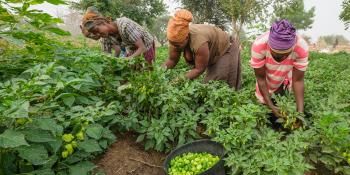Agricultural systems modelers can strengthen their work analyzing food security

New working paper assesses the current state of practice for the representation of food security indicators in agricultural systems models.
There is broad agreement among the international community about the importance of linkages between agriculture and food security. However, a working paper by the CGIAR Research Program on Climate Change, Agriculture and Food Security (CCAFS) written by an international and interdisciplinary team of researchers indicates that these linkages often could be better represented in quantitative analyses.
"We found that most analyses of food security using agricultural systems models focused on the food availability component of food security, such as yields or production, rather than on the food access and stability components,” noted Charles Nicholson of Cornell University, who leads the team.
Food security definitions often focus on four elements: food availability, access, utilization, and their stability over time. An 'agricultural systems model' is an empirically-based model that most commonly includes biophysical relationships (often at the farm or field level) sometimes complemented by economic content.
The working paper recommends that agricultural systems analyses of food security focus more on food access indicators such as (1) food consumption expenditures, (2) experience-based food insecurity scales (for example, the Food Insecurity Experience Scale or the Household Food Insecurity Access Scale), and (3) household dietary diversity such as the Household Dietary Diversity Score. Researchers who focus on public health now emphasize measures of food security using experiential scales, which ask individuals or households about how they have 'experienced' food security during a particular period of time. These scales encompass both the availability and access components of food security, which is relevant because improved availability does not always translate into greater access for agricultural households.
The paper also notes the need to strengthen the evidence base linking these experiential indicators to the agricultural production outcomes common in agricultural systems analyses. To illustrate the challenges and benefits of a focus on food access indicators, the working paper describes two agricultural systems models that include the three recommended food security indicators. Analyses with these models demonstrated that each of the three indicators responded differently over time in response to shocks such as drought conditions or policy change, which suggests that there is value in representing multiple food security outcomes. The team also proposed specific quantitative methods to represent the stability component of food security outcomes.
The team reviewed more than 1600 publications that modeled food security at the household and regional levels. Fewer than 10 previous publications used experiential scales to assess food security outcomes, and only a similar number attempted to assess formally the stability dimension of food security.
The working paper recommends broad dissemination of the findings of this study to the agricultural systems modeling community to raise awareness of the current limitations of modeling practice with respect to food security outcomes. It is also relevant to communicate with the human nutrition community to raise awareness of agricultural systems modeling approaches and their potential for expanding the boundaries of inquiry regarding the impacts of food systems and agriculture on nutrition outcomes.
Read more:
- Working paper: Setting priorities to address the research gaps between agricultural systems analysis and food security outcomes in low- and middle-income countries
Charles F. Nicholson is an Adjunct Associate Professor in the Charles H. Dyson School of Applied Economics and Management and International Professor of Applied Economics and Management, International Programs, College of Agriculture and Life Sciences, Cornell University.



